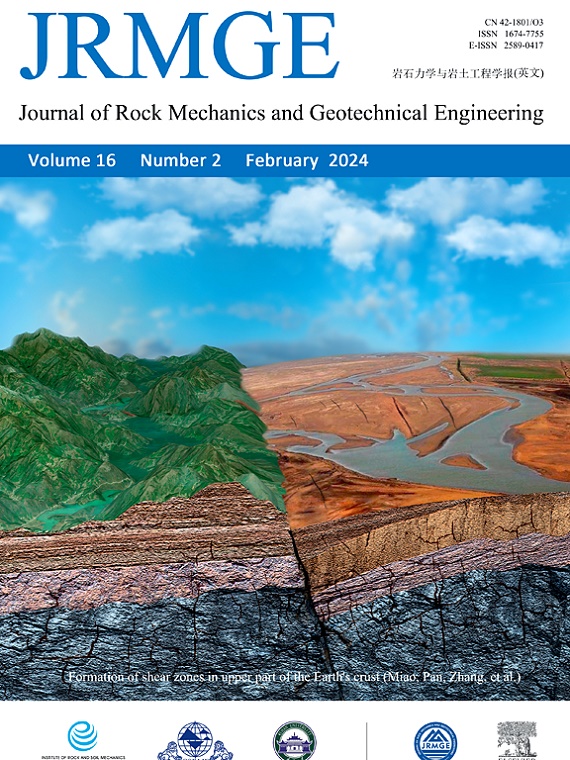Discontinuity development patterns and the challenges for 3D discrete fracture network modeling on complicated exposed rock surfaces
IF 10.2
1区 工程技术
Q1 ENGINEERING, GEOLOGICAL
Journal of Rock Mechanics and Geotechnical Engineering
Pub Date : 2023-10-01
DOI:10.1016/j.jrmge.2023.09.004
引用次数: 0
Abstract
Natural slopes usually display complicated exposed rock surfaces that are characterized by complex and substantial terrain undulation and ubiquitous undesirable phenomena such as vegetation cover and rockfalls. This study presents a systematic outcrop research of fracture pattern variations in a complicated rock slope, and the qualitative and quantitative study of the complex phenomena impact on three-dimensional (3D) discrete fracture network (DFN) modeling. As the studies of the outcrop fracture pattern have been so far focused on local variations, thus, we put forward a statistical analysis of global variations. The entire outcrop is partitioned into several subzones, and the subzone-scale variability of fracture geometric properties is analyzed (including the orientation, the density, and the trace length). The results reveal significant variations in fracture characteristics (such as the concentrative degree, the average orientation, the density, and the trace length) among different subzones. Moreover, the density of fracture sets, which is approximately parallel to the slope surface, exhibits a notably higher value compared to other fracture sets across all subzones. To improve the accuracy of the DFN modeling, the effects of three common phenomena resulting from vegetation and rockfalls are qualitatively analyzed and the corresponding quantitative data processing solutions are proposed. Subsequently, the 3D fracture geometric parameters are determined for different areas of the high-steep rock slope in terms of the subzone dimensions. The results show significant variations in the same set of 3D fracture parameters across different regions with density differing by up to tenfold and mean trace length exhibiting differences of 3–4 times. The study results present precise geological structural information, improve modeling accuracy, and provide practical solutions for addressing complex outcrop issues.复杂暴露岩体表面不连续发育模式及三维离散裂缝网络建模的挑战
天然斜坡通常显示复杂的裸露岩石表面,其特征是复杂而剧烈的地形起伏和无处不在的不良现象,如植被覆盖和落石。本文对复杂岩质边坡裂缝形态变化进行了系统的露头研究,并对复杂现象对三维(3D)离散裂缝网络(DFN)建模的影响进行了定性和定量研究。目前对露头断裂模式的研究主要集中在局部变化上,因此,我们提出了对露头断裂模式全局变化的统计分析。将整个露头划分为若干子带,分析了裂缝几何性质在子带尺度上的变异性(包括裂缝的方位、密度和迹线长度)。结果表明,不同亚带的裂缝特征(如集中程度、平均方位、密度和迹线长度)存在显著差异。此外,与坡面近似平行的裂缝集密度在所有子带中都明显高于其他裂缝集。为了提高DFN模型的精度,定性分析了植被和落石对三种常见现象的影响,并提出了相应的定量数据处理方案。随后,根据分区尺寸确定了高陡岩质边坡不同区域的三维裂缝几何参数。结果表明,同一组三维裂缝参数在不同区域之间存在显著差异,密度差异可达10倍,平均迹线长度差异可达3-4倍。研究结果提供了精确的地质构造信息,提高了建模精度,为解决复杂露头问题提供了实用的解决方案。
本文章由计算机程序翻译,如有差异,请以英文原文为准。
求助全文
约1分钟内获得全文
求助全文
来源期刊

Journal of Rock Mechanics and Geotechnical Engineering
Earth and Planetary Sciences-Geotechnical Engineering and Engineering Geology
CiteScore
11.60
自引率
6.80%
发文量
227
审稿时长
48 days
期刊介绍:
The Journal of Rock Mechanics and Geotechnical Engineering (JRMGE), overseen by the Institute of Rock and Soil Mechanics, Chinese Academy of Sciences, is dedicated to the latest advancements in rock mechanics and geotechnical engineering. It serves as a platform for global scholars to stay updated on developments in various related fields including soil mechanics, foundation engineering, civil engineering, mining engineering, hydraulic engineering, petroleum engineering, and engineering geology. With a focus on fostering international academic exchange, JRMGE acts as a conduit between theoretical advancements and practical applications. Topics covered include new theories, technologies, methods, experiences, in-situ and laboratory tests, developments, case studies, and timely reviews within the realm of rock mechanics and geotechnical engineering.
 求助内容:
求助内容: 应助结果提醒方式:
应助结果提醒方式:


